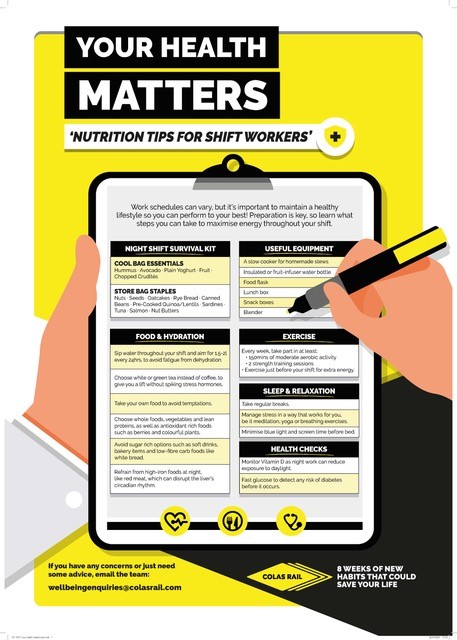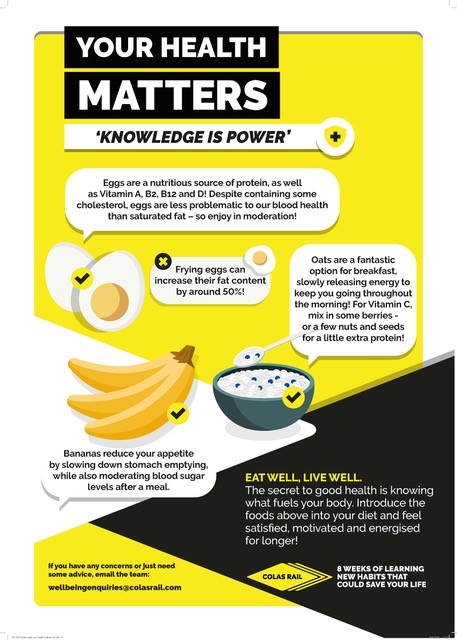Case Study: Colas Rail - embedding wellbeing into complex delivery projects
When planning large complex delivery projects, Colas Rail have made it a priority to include ways to support people to adopt positive health behaviours.
As part of the South Rail Systems Alliance Bristol East blockade, the project leadership team took a ‘health by design’ approach. This was the first time that health and wellbeing had been designed into a project from the outset creating a project environment that supports a culture of health.
As well as being the right thing to do, leadership wanted to set out the behaviours and expectations for the project team.
It turned out that this had benefits for project performance as well as staff health.
What alerted Colas Rail to the risk
The Bristol East project was on a large and complex site with high risk because it involved working alongside live lines. Colas Rail needed employees able to function and perform at the highest levels over an extended period of time.
Over the course of a long project it is common to find that motivation and concentration levels can dip part-way through the project cycle. This poses a safety risk, raising the likelihood of accidents or slips. Colas Rail wanted to reduce this risk.
How did Colas Rail plan & design the intervention?
An important success factor in achieving positive workplace changes is securing leadership commitment early in the development of wellbeing programmes. From the outset, the programme was led by operational leadership to design health and wellbeing into the project environment.
They adopted an integrated multilevel approach. This included looking at the how the project environment supports health and wellbeing, as well as supporting individual capability and motivation to change. The aim was to provide an array of choices so that everyone could start somewhere and get something from the programme, regardless of their fitness level or willingness to change.
What did Colas Rail do to address the identified health and wellbeing risks?
Increased knowledge and access to nutritious food and good eating habits
The on-site catering menu was designed by nutritionists and food choices were realistic and aligned to manual work. Catering provision was delivered by local caterers trained to support healthy eating habits, so they could actively encourage people to make healthy decisions.
This was combined with providing information about the impact of food choices on health and energy levels. Information campaigns on healthy habits and eating were delivered via posters, table leaflets, toolbox talks and learning sessions. To encourage healthy habits beyond the workplace, QR codes to download recipes and open access webinars were made available to share with partners and families.
In order to promote healthy options as the default choice, there were no vending machines on site.
Partnered with experts to link health promotions into other elements of programme
The project carried out assessment of health needs including body composition measurement and ‘Know your Numbers’ checks in partnership with external providers. This supported individuals to benchmark their own health and to understand health risks for the business. A specialist nutrition consultancy provided support for shift working, healthy eating and fatigue using open access webinars to improve ease of access by staff.

Created motivation to keep fit at work
‘Smoothie bikes’ were provided as part of the project. These have an attachment at the front for a smoothie maker so when you pedal it blends the smoothie. This encouraged participation in physical activity and as an awareness tool to provoke discussion around healthy habits. Easily accessible fitness sessions with wellbeing partners were adapted to be applicable to everyone, in any location.
Educated employees on importance of hydration on performance and safety
Solar powered chilled water fountains were positioned around the site to provide staff with hydration opportunities. This was linked to posters and promotional campaigns.
A variety of channels were used to increase staff exposure to health messages
The communications campaign to support the initiative was designed to be delivered over eight weeks. It used both formal and informal campaign mechanisms, and rotated awareness materials to support the wellbeing journey of employees through the programme. Touchpoints within the campaign included extending safety briefings to include wellbeing messages, toolbox talks, mess table takeaway materials, site locations for posters, and making time available for staff to attend webinars.

Leadership was actively involved in promoting the programme
Both project leadership and expert partners were proactive in promoting the programme activities and encouraging participation. It was recognised that changing norms takes time and therefore prompting people to behave differently was actively continued for the duration of the programme.
Overall this was an integrated programme that signalled a personalised and inclusive approach by including numerous pillars of healthy behaviours, with easily accessible facilities that provided ‘default’ healthy options and partnership with experts to secure broad participation.
What challenges were identified and overcome?
Providing information alone is not enough for employees to change their behaviour. There may also be environmental (or cultural) barriers to taking positive action in the workplace.
In this project, shift work was identified as a barrier to making healthy choices, so initiatives were planned both to address the risks of shift work to health and actively encourage participation of shift workers. Key initiatives such as body composition measurement were offered at times to suit different shifts.
Not all employees had access to, or wanted to use, technology. Therefore reaching the whole workforce required planning to ensure that multiple touch-points were used to reach as many people as possible on multiple occasions. Using an open access platform that did not require login details enabled everyone to access the webinars and promotional information easily. They could also take this information home.
A gradual process of familiarisation and encouragement was required to overcome resistance to uptake of the health needs assessment. Strong leadership buy-in encouraged people to attend and participate. Momentum for the service was built as the project progressed through open discussions about health and wellbeing between managers and employees, using early-adopting participants as role models and positive storytelling. Linking health habits to project safety outcomes also helped promote participation.
It was important to acknowledge the size and complexity of the project environment at the outset. This enabled the programme to be seamless and streamlined in design so it could be implemented around working practices. Continuity of health partners was also key to success – having partners available regularly to conduct health promotion encouraged uptake.
What has the programme meant for frontline staff?
There was plenty of discussion during this project about its wellbeing focus. Several companies external to Colas stated they had never seen this approach in this way before. A meeting to review body composition results, 12 weeks after the first, had people queueing and urging each other on – creating a great camaraderie and a little friendly competition!
The popularity of the wellbeing events has spread to other parts of the business and forms a part of several booked training days that employees enjoy.
How are Colas Rail measuring outcomes and taking this forward?
The programme was primarily measured in terms of engagement which remained high throughout the project lifecycle. Outcomes were also linked to safety performance. There were no accidents or slips, and no lost time due to this. Eight weeks is a short period of time over which to measure behavioural change, but if this approach was included in all major projects in future, it would provide the continuity of culture needed to support habit change.
Subsequent events using body composition measures have been used to gather high level personal targets, freely given by participants, within a 10-month wellness programme (currently running). These personal targets include increasing muscle, dropping weight and more effective exercise. Colas Rail will use the impacts seen at the end of the current programme to show the longer-term benefits of this approach, and participants will also have a much longer time to see the results and maintain new habits.

